
Thematically Sikh paintings are rare. Thus, when I came across the paintings below, I thought I should share. The oil paintings below are the work of Jaswant Singh Zafar. He’s a poet, photographer, and painter in his free time and an engineer in Ludhiana by day. This year, he’s spending his free time creating a series of paintings under the theme of ‘Gurbani.’ The paintings completed thus far weave the mool mantar through various aspects of nature, shapes, and other backgrounds.
At the end of the year, the series will be in an exhibition at the Artmosphere Gallery in Ludhiana. Artmosphere was created to provide a platform for budding artists in Ludhiana and Punjab such as Jaswant Singh Zafar. Such an endeavor cheers me and gives hope that the visual arts scene there is growing.

I appreciate these paintings because they provide some insight into the art scene in Punjab- an example of what’s happening there. More works from this series can be found here.
Kes is an important part of the Sikh identity but it also carries social, cultural, and political meaning for more than just Sikhs. Recently, a film student from NYU explored this less explored cross-cultural perspective by speaking with 3 individuals from various backgrounds in an interesting (and short-18 minute) documentary.
The film engages with a Sikh (Sonny Singh from the Sikh Coalition’s New York office), an African-American woman, and a woman with trichotillomania – a disorder that causes the sufferer to compulsively pull out hair. We often consider kes in the context of religion, beauty, and identity; but rarely do we do so in a cross-cultural perspective (unless you grew up in a culturally diverse community). The film is thoughtful and thought-provoking, so I’ll let it speak for itself. It includes footage from the recent Sikh Day parade in New York City, as well as a pagh tying competition in Richmond Hill.
[hat tip: sonny]
Hair… As one of the most important aspects of how others see us, how has our hair become interwoven with issues of race, religion, beauty, and identity?
Sikhism mandates that the hair is never cut. We explore the rationale behind this and the discrimination that Sikhs face today in a post 9-11 world.
Many women of African descent grow up to think negatively about their natural hair. So begins the burdensome, expensive, and often painful process of weaves and chemical straightening, as a however subconscious attempt to achieve a homogenized concept of beauty. We speak to a woman who takes pride in her natural hair and is committed to show others how truly beautiful “nappy” hair can be.
Sometimes what we do with our hair is not a choice. Trichotillomania is a disorder that causes the sufferer to compulsively pull out hair. We will meet a long-term lash/brow puller who describes how people have reacted to her disorder and how these experiences have shaped her. [link]
Gatka owes its early development to the Shaster Vidiya, literally meaning knowledge of the arms. This was a warrior curriculum used by the Sikhs for military training. [link]
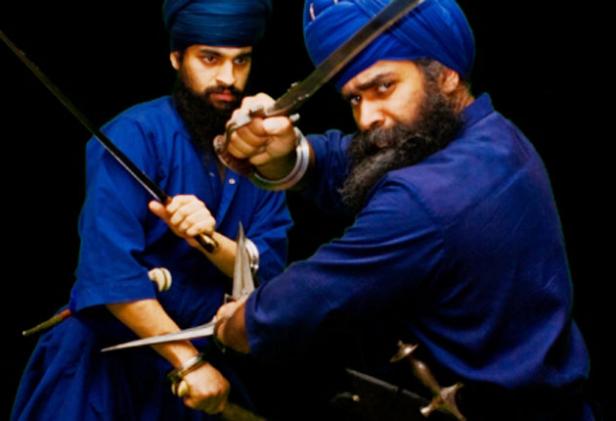 A fascinating article in a UK newspaper highlights the return of Shaster Vidiya – the “world’s original martial art” which was banned by the Raj after the final defeat of the Sikh empire in the mid-19th century. Considered a forgotten art form, Shastar Vidiya was practiced in North India before the emergence of Sikhism. However, it was the Sikhs who were known to have fully mastered this particular fighting style.
A fascinating article in a UK newspaper highlights the return of Shaster Vidiya – the “world’s original martial art” which was banned by the Raj after the final defeat of the Sikh empire in the mid-19th century. Considered a forgotten art form, Shastar Vidiya was practiced in North India before the emergence of Sikhism. However, it was the Sikhs who were known to have fully mastered this particular fighting style.
Now, it seems, young British Sikhs are attempting to revive this lost art form. Their teacher, a controversial figure named Nidar Singh Nihang, has been studying the art of Shastar Vidiya for the past 20 years in hopes of passing it onto the younger generation. Students begin learning how to fight with simple wooden sticks. However, those who show a particular skill and dedication are allowed to practice with the kind of swords that once made the Sikh armies so powerful. The article points out the irony of a British Sikh trying to resurrect shastar vidiya given the history,
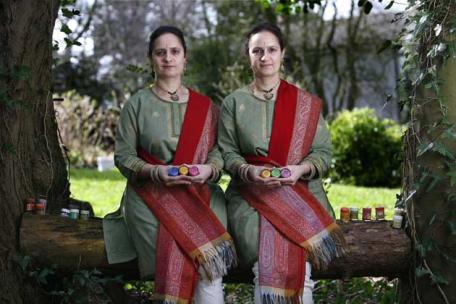 Does the West’s emphasis of the individual subvert community consciousness in the art world? UK-based artists Amrit and Rabindra Singh explain that the primacy of the individual versus other relationships does not resonate with art elites as naturally as it may for others:
Does the West’s emphasis of the individual subvert community consciousness in the art world? UK-based artists Amrit and Rabindra Singh explain that the primacy of the individual versus other relationships does not resonate with art elites as naturally as it may for others:
“Western contemporary art is all about the individual, the inner self,” reflects Amrit… We were constantly being told that to be individual was healthy, that we had to be more different from each other, be influenced by different Western artists from each other, but that didn’t seem valid to us. From the point of view of Sikh, Indian or even Asian philosophy, the community comes first and the individual is second.” [emphasis added]
I thought this article was a fascinating description and reflection on the structural challenges Sikh artists, particularly Sikh women of color artists, face within the art establishment in the U.K.
The twins described their sense of community and of shared experiences when conceptualizing and creating their art. This first barrier — that art that does not conform to the frame of mainstream art teaching — seems obvious, and yet such a subtle feature that it makes it difficult to push around it. This is a fairly distinct difference (individual vs. multiple social awarenesses) of philosophical development between the canon of European/American philosophers and philosophers from the different regions of Asia, but it was fascinating to see how it repeats and excludes through artistic representation. Not only that, it creates a less obvious form of discriminatory thinking in the art academy than the standard, run-of-the-mill racism.

 Remember that one particular Kenneth Cole ad in NYC that caught our eye? Yes, the picture of the sardar who received much admiration from Sikhs and non-Sikhs around the globe. Well, as it turns out – he’s back. Sonny Caberwal is being featured in GQ’s upcoming Spring/Summer 2009 (German?) publication. Unfortuantely, there isn’t much press around it yet – but what we do have are some pictures from the shoot in Germany.
Remember that one particular Kenneth Cole ad in NYC that caught our eye? Yes, the picture of the sardar who received much admiration from Sikhs and non-Sikhs around the globe. Well, as it turns out – he’s back. Sonny Caberwal is being featured in GQ’s upcoming Spring/Summer 2009 (German?) publication. Unfortuantely, there isn’t much press around it yet – but what we do have are some pictures from the shoot in Germany.

–
As with the Kenneth Cole ad – it’s great that the image of the sardar is receiving positive attention. Perhaps it will encourage those who aren’t familiar with Sikhs to learn more. I said perhaps. More realistically, the page will be turned (no, not all Sikh men dress that well like that) and Sikhs will still be unknown. It’s in our human nature to see something unfamiliar, and then go back to our dinner and never think of it again (take Darfur for example). And while it’s great that Sonny is getting these wonderful opportunities (Sikh PR right?) – we should definitely save room for other Sikh male fashionistas… like this one from one of my fav sites The Satorialist! After the jump…
As I was randomly going through youtube clips a few days ago, I came across the above video of a group of Sikh children in Fremont, who learn kirtan in classical raags. Despite the poor audio, its obvious that they are good and I know this also from having heard them (and some of their contemporaries) in person – they are GOOD.
A couple of weeks ago Jodha reported on an article that brought to light the fact that Sikh children are practicing the tradition of kirtan, but what I think we didn’t discuss there is how this generation of Sikh musicians has really become one of classical musicians, learning stringed instruments of old and performing keertan in the Classical or raag framework. The growth has been obvious, especially in recent years – with the rise of institutions such as the The Raj Academy in Great Britain and the Gurmat Sangeet Department at Punjabi University Patiala, which specialize in providing instruction in traditional (classical) kirtan, and even the Miri Piri Academy in Amritsar of which the Chardi Kala Jatha (classically trained professional Sikh musicians who happen to be American in nationality) is a product.
 Yet another inexplicable case of profiling has come to light. On January 26th, 36 year old Rashad Bukhari arrived from Pakistan with a valid multi-entry visa into the US. Bhukhari is a former employee of the U.S. Institute for Peace, and currently the Urdu-language editor of the Common Ground News Service, whose goal is to build bridges between the Muslim world and the West. The news service is funded by the Search for Common Ground, a conflict resolution and conflict prevention ngo.
Yet another inexplicable case of profiling has come to light. On January 26th, 36 year old Rashad Bukhari arrived from Pakistan with a valid multi-entry visa into the US. Bhukhari is a former employee of the U.S. Institute for Peace, and currently the Urdu-language editor of the Common Ground News Service, whose goal is to build bridges between the Muslim world and the West. The news service is funded by the Search for Common Ground, a conflict resolution and conflict prevention ngo.
Immigration officials at Dulles could have easily verified all of this if Rashad had been allowed to make a phone call or if they themselves had chosen to check. Rather, they detained him for 15 hours, temporarily took away his cellphone and laptop, and eventually put him on a plane back to Pakistan. They prepared a transcript of the encounter in which an official justifies the United States not honoring Rashad’s visa by saying, “You appear to be an intending [sic] immigrant.” [Washington Post]
Bukhari was refused entry because the immigration agent he spoke with found that he was an “intending immigrant” or that he had an intent to remain in the US. His visa was a temporary visa (probably visitor). However, Bukhari has a wife and three children in Pakistan, a return ticket there, and a good job, all of which would normally indicate that he has no intention of remaining here in the US. The number of connections you have in your home country is what determines whether you have ‘an intent to remain’ in the US, and Bukhari’s connections, in ordinary circumstances, would be more than enough to assure authorities that he would return to Pakistan.
In words that don’t appear on the transcript of the case, the official told Bukhari that he could “voluntarily” withdraw, return to Pakistan, and reapply for another visa, or face a five year ban. So he left, and now faces the consequences that accompany being refused entry at a border.
 While many may still be reveling in Slumdog’s Sunday limelight, a darker movie about Indo-Canadians in Vancouver (the vast majority of who are Punjabi-Sikh), aiming to shed light on gang violence, is sparking criticism. [See trailer here.]
While many may still be reveling in Slumdog’s Sunday limelight, a darker movie about Indo-Canadians in Vancouver (the vast majority of who are Punjabi-Sikh), aiming to shed light on gang violence, is sparking criticism. [See trailer here.]
The film titled “A Warrior’s Religion” was made by Mani Amar, who describes it as a poetic documentary. When asked about what drove him to make the film, he said:
“It had to be done. How many more people need to die? We are past the 130 mark of deaths in our community. The issue is not slowing down … How readily we have accepted gang violence and how engrossed we are in it is what propelled me to do it. We are so relaxed about an issue that we should not be relaxed about at all.” [link]
In the film, Mani interviews Bal Buttar, a high-profile former gang member who is now blind and a quadriplegic after being shot in a gang related incident.
Mani said: “When I met Buttar, I laid it out on the table directly to him and said to Buttar, “I don’t respect you. You have an opportunity in your life to show youth that this is what gang violence will bring you.” For whatever reason, Buttar accepted the challenge. In the end though, I reaffirmed that it’s only death or jail to get out.” For Mani, what resonated most from the interviews was Buttar’s way of explaining karma: “You take blood. That blood gets taken from you.” [link]
Controversy has arisen from the film’s name, “A Warrior’s Religion,” and its use of visual references to Sikhism through images of gurdwaras, scenes from a Vaisaikhi parade, martyrs, and an image of a khanda in flames with bullet holes in the background. Mani explains how he chose the name:
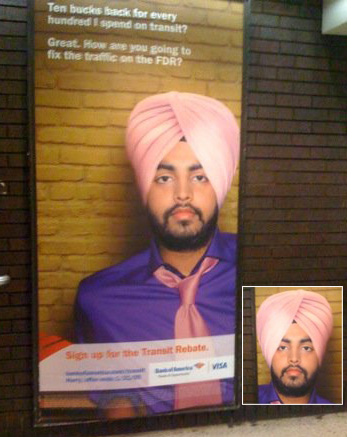 Lookout New Yorkers! There’s a new Sikh in town! Where is he? Who is he? He’s on your subway wall… representing Bank of America, sporting a NICE pagh with the cleanest layers I’ve seen in a long time. It looks like the folks at Kenneth Cole’s might have some competition…
Lookout New Yorkers! There’s a new Sikh in town! Where is he? Who is he? He’s on your subway wall… representing Bank of America, sporting a NICE pagh with the cleanest layers I’ve seen in a long time. It looks like the folks at Kenneth Cole’s might have some competition…
The designers obviously weren’t Sikh because they messed with his pagh and flipped it- maybe to make it look more original. The inset of the picture on the left shows the model with his pagh properly tied – with the larhs (layers) on the right.
Previous discussions of Sikhs in the media, entertainment and modeling:
I spent the past weekend surrounded by Sikh Art and Film at the annual Spinning Wheel Film Festival in Hollywood. I usually attend these events with high expectations, hoping to be inspired and moved and there are always one or two films that provide that sustenance. The films were creative, such as The Making of Liverpool – an artistic animation inspired by a painting by The Singh Twins which explores 800 years of Liverpool’s history. The films were educational, such as Cultural Safari – directed by Sandeep Singh and produced by the Kaur Foundation – describing the basics of Sikhi for children of all ages [I have to say that this is one of the most impressive educational films I have come across]. The films were also daunting, such as Warrior Boyz – made by Baljit Sangra which touched upon the root causes of gang violence in the Punjabi community of Vancouver. A favorite of the crowd was Kuldip Powar’s Unravelling – a poetic inter-generational dialogue between the film director and his grandfather about the experience of war all posed in Urdu poetry.
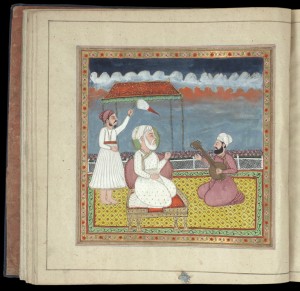 There were many other well-made films such as 35, Kabaddi Cops, and Right to Turban which rightfully deserve mention (and have been discussed or will be discussed in future posts), however what I appreciated most about the weekend was the final day of the festival – which was devoted to lectures on Sikh Art and History. Staff from the Anglo Sikh Heritage Trail and other UK-based organizations presented the attendees with a glimpse into the historical legacy of the Sikhs. One of the lectures was titled the Epic of Saragarhi and discussed the 21 soldiers of the Sikh regiment who defended a remote post against an estimated 10,000 hostile tribesmen. Michael O’Keefe from the British Library discussed Sikh artifacts and paintings and detailed an image of Maharani Jindan Kaur’s Gutka of the Sukhmani Sahib (see picture to the left). The day ended with a panel showcasing Sikhs in Theatre and Music, including traditional music and also hip-hop. Mandeep Sethi and Jagmeet Singh, rappers from LA, ended the festival with amazing performances showcasing their incredible talent of telling stories through hip-hop.
There were many other well-made films such as 35, Kabaddi Cops, and Right to Turban which rightfully deserve mention (and have been discussed or will be discussed in future posts), however what I appreciated most about the weekend was the final day of the festival – which was devoted to lectures on Sikh Art and History. Staff from the Anglo Sikh Heritage Trail and other UK-based organizations presented the attendees with a glimpse into the historical legacy of the Sikhs. One of the lectures was titled the Epic of Saragarhi and discussed the 21 soldiers of the Sikh regiment who defended a remote post against an estimated 10,000 hostile tribesmen. Michael O’Keefe from the British Library discussed Sikh artifacts and paintings and detailed an image of Maharani Jindan Kaur’s Gutka of the Sukhmani Sahib (see picture to the left). The day ended with a panel showcasing Sikhs in Theatre and Music, including traditional music and also hip-hop. Mandeep Sethi and Jagmeet Singh, rappers from LA, ended the festival with amazing performances showcasing their incredible talent of telling stories through hip-hop.
While the film festival brought together a plethora of Sikh art mediums – what it did seem to be missing was the representation of women and the voice of women in these films. The films were predominately made by men and the issues discussed were predominately issues affecting men. This brought several issues to mind – do young Sikh women not feel encouraged to enter the field of Film? Do the current male Sikh filmmakers not feel comfortable telling the story of Sikh women? It seems to be of vital importance that as we develop and promote Sikh films, we ensure that the stories we tell are representative of the entire Sikh panth and pay particular attention to the stories of Sikh women.
I will leave with this quote, mentioned by Harbinder Singh of the Anglo Sikh Heritage Trail, but also very pertinent to the theme of this weekend’s film festival.
Until lions tell their own history,
History will always glorify the hunters.
– African Proverb
A movie you might be interested in, Slumdog Millionaire, is being released in major cities today and most other North American cities throughout the next few weeks. The plot might sound corny to the skeptical (it involves some romance), but if it’s as well done as it seems to be from the trailer, it could be one of those poignant, moving films that only come along once every few years (in the genre of Born into Brothels). The trailer gives away a lot, so if you like to be surprised, don’t watch all (or any) of it. (The skeptic in me is hoping it’s not a touristy, voyeuristic ride into areas that most movie-goers will only go to through the movie…)

An interesting theme that came up in the making of the movie is product displacement. Apparently Mercedes and “a well known soft drinks company” objected to their products being shown in a slum and demanded that their logos be removed, which was done digitally, costing tens of thousands of pounds. Yet, the Benz folks were perfectly happy having their logo appear on a gangster’s car when it was parked outside his mansion. So it’s ok to engage in mass (probably violent) crime as long as you’re wealthy. Mercedes will hang with you. But if you want to try to earn an honest living, and just can’t make it out of poverty- sorry, no such luck. [Timesonline]
The car manufacturer and a well-known soft drinks company believed that their brands would be sullied if their products were shown in one of Bombay’s shantytowns. [Timesonline]
Hey, Mercedes and fizzy drink company- you may have missed one of the points of the movie-you know, here’s the human struggle and spirit, from the eyes of someone you didn’t realize you had so much in common with??… Never mind. (I’m trying to not let their stupidity ruin the movie for me.)
More absurdity, synopsis and release dates below the fold.
Some ideas are just better communicated through modes other than writing. Theatre, through the unfolding of a story and through the body language of its actors, can sometimes convey meaning and ideas more effectively than just written words alone.
Some Sikh youth from Rockland, MD have decided to use theatre to engage non-Sikhs in learning about Sikhs- a wonderful idea.
Two plays are being planned for the fall expressing themes of diversity, mutual respect, interfaith and justice. They will both be staged on Saturday December 13, 2008 at the Wooten High School in Rockville, Maryland.
Where did this idea come from?
Last fall, Guru Gobind Singh Foundation had some of its kids take part in a play The Lorax, a musical adaptation from the famous Dr Seuss story book which was staged by kids from many different faiths. This play, adopted to create awareness about environment, was coordinated by the Interfaith Conference of Metropolitan Washington and was staged by the Children’s Theater Company of New York.
After going through this experience, GGSF decided to form the Rockville Chapter of Children’s Theater Company last May to explore the possibility of staging a play depicting the concepts of Guru Granth Sahib. Dedicated to “Building Character Onstage”, the Children’s Theatre Company (CTC) of New York develops in children and youth a keen sense of citizenship while introducing them to the incomparable magic of theatre through their full participation in the creation and performance of musicals and plays. [link]
Over the next few weeks Sikhs will join together to celebrate the 300th anniversary of the Sri Guru Granth Sahib. Just like many of you, I’ve been reading articles and stories about the various celebrations and I’ve come across some amazing and enriching images showing how the concepts of Sangat, Seva, and Guru come together. So I thought that in place of writing a post for once – I would instead create a mosaic of some of the images I have come across which represent the celebrations in one way or another. Pictures really do speak louder than words. [You can click on the image for a closer look].
Heads-up friends, the season of the “Spinning Wheel Festival” is about to begin across North America this autumn. Celebrating Sikh films and art, the first stop will be in New York City on Saturday, October 04, 2008 at the Asia Society & Museum (p.s. that’s next Saturday). Buy your tickets NOW! The wonderful Rabbi Shergill will be performing at the opening gala (yes I am really biased here … I heart Rabbi Shergill) and DJ Rekha will be literally “spinning” at the after party.
Films a the NYC festival will range from documentaries on Pahelwani (i.e. Panjabi wrestling) and Kaba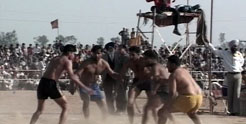 ddi-playing Canadian police officers to issues affecting the Sikh community from 1984 and post-9/11 hate crimes. There will also be short and feature films. For example, one on a young boy’
ddi-playing Canadian police officers to issues affecting the Sikh community from 1984 and post-9/11 hate crimes. There will also be short and feature films. For example, one on a young boy’ s struggle to keep his hair while his family fears the obstacles he will encounter and another on “… a young Sikh doctor struggling with the inequities of the American Health System and ultimately his own identity”. The Holy Duels of Hola Mohalla is a film looking at the Khalsa Panth.
s struggle to keep his hair while his family fears the obstacles he will encounter and another on “… a young Sikh doctor struggling with the inequities of the American Health System and ultimately his own identity”. The Holy Duels of Hola Mohalla is a film looking at the Khalsa Panth.
The films seem interesting both in content and presentation. The stories are grounded in the realities many of us encounter everyday. You can get a full listing of the films and their synopses here.
In the past, I have attended the “Spinning Wheel Festival” at one of its many North American stops and found it a great space for artists and art-enthusiasts to be exposed to Sikh creativity. I remember there being a panel discussion with the directors and the audience. We don’t have too many of these creative opportunities in our community even though we spend plenty of time and space advertising foreign medical schools in Poland, China, and the Caribbean.
I have found that some films are really hit or miss at these festivals, but it’s expected sense the focus is on cultivating and inspiring creativity; while, building a permanent Sikh film festival for years to come. Cash prizes are awarded to the “bests” in various categories. I have been told that the listing and quality of films varies across the different North American stops.
At the end of the day why not go, especially if it’s close by. I personally think it’s worth a visit as an act of supporting Sikh arts and learning about the various issues affecting our community. Sometimes we get too caught up in our own worlds and don’t realize these issues are taking place or we are in amidst of them and they become normal parts of our lives leaving very little room for reflection or exposure to others’ perceptions. Thus, it’s an 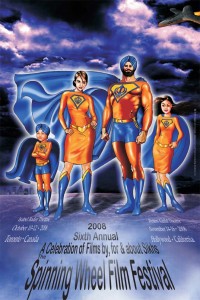 opportunity to get a fresh/new look at various issues.
opportunity to get a fresh/new look at various issues.
Lastly, the arts, from painting and photography to films and music, are our community’s soul! They help us speak in ways we can’t always articulate. So go save your soul and attend a Sikh artistic event! 🙂
Okay, enough of the attempt at convincing … the other North American stops will be:
- Toronto, Canada from October 10-12, 2008 at the Isabel Bader Theatre.
- Hollywood, California from November 14-16, 2008 at the Writers Guild Theatre.
Are ya’ll thinking of going? What have your experiences been at the various Spinning Wheel Festivals? Does anyone know of other North American stops?
p.p.s. The Toronto and Hollywood poster is really interesting isn’t it … a conversation in of itself!
“Towelhead” is the title of a forthcoming Warner Brothers movie. The Sikh-American Legal Defense and Education Fund (SALDEF) is not pleased. Today, SALDEF issued a press release in which it states:
“The word ‘towelhead’ is a crude and racist slur that is commonly hurled at Sikhs and has frequently been documented in connection with hate crimes,” said Kavneet Singh, SALDEF’s Managing Director. “Calling a movie ‘Towelhead’ is like calling a movie ‘Nigger’ or ‘Gook,’ and we are shocked that a company like Warner Brothers would even consider using a racial slur as a movie title.”
On this Mother’s Day let’s celebrate by listening to Punjabi music’s tributes to our mothers!
To start off, I would like to share a BEAUTIFUL song by Gurdas Mann, “Mawaa Thandiyaa Chawaa”.
There is also the song, “Maa”, sung by Malkit Singh with the beautiful line “maa daa rishtaa sab toau sachaa … maa hai rab da roop” [a mother’s relationship is the most truthful …. A mother is the beauty of God].
Please share your favorite “Maa” song and I hope you can dedicate it to her too!
What moves you (both physically and emotionally)? Hip hop, the dhol, or Surinder Kaur? Artists, musicians and dancers often use their skill and art as a medium to promote their ideas.
The music of the Staple Singers soundtracked the civil rights movement: it was their songs that were sung on protest marches; Martin Luther King was a close friend of Pops Staples. “Pop, he always told the songwriters: if you wanna write for the Staples, read the headlines,” she says. “‘Cause we wanna sing about what’s happening in the world.
You’ve probably heard the classics “I’ll Take You There” and “Respect Yourself” by the Staple Singers…
The jazz writer Stanley Crouch once described the sound of the Staple Singers as “joy and thunder”. From the 50s, the family group, led by Roebuck “Pops” Staples, married a rumbling gospel with soul and blues and politics, creating hits such as I’ll Take You There and Respect Yourself.
Music has played a significant role in mobilizing social and political movements- from the Civil Rights movement in the U.S. to the anti-apartheid movement in South Africa by its power to move people emotionally and also to convey information .
We talk a lot about issues our community faces- what music motivates you to face those issues?
Do artists have a responsibility to engage with the issues of their day? Or do activists have a responsibility to make music about their ideas to connect with their audience?
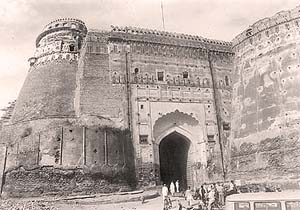 Good news! After years of coaxing and clamoring by Sikhs worldwide, the SGPC has recently committed to preserving Sikh buildings in their historic condition – instead of updating facades with rows of crisp white 4×4 tile, layers of white paint, and sheets of white marble, among other forms of traditional Sikh rehabilitation. The conduits for the SGPC’s work of keeping up historic and new buildings are the groups of Kar Seva Wale Babe and this week the SGPC announced that:
Good news! After years of coaxing and clamoring by Sikhs worldwide, the SGPC has recently committed to preserving Sikh buildings in their historic condition – instead of updating facades with rows of crisp white 4×4 tile, layers of white paint, and sheets of white marble, among other forms of traditional Sikh rehabilitation. The conduits for the SGPC’s work of keeping up historic and new buildings are the groups of Kar Seva Wale Babe and this week the SGPC announced that:
‘kar seva wale’ saints will be requested to maintain the original structures without making additions or alternations.
This is amazing news because in the past a lot of valuable Sikh history and art in the form of frescos and architectural detail has been lost due to the SGPC’s building renovations and updates. Now there seems to be an affirmative acknowledgment that such things can’t continue to happen – a step in what a lot (including I) feel is the right direction. However, the announcement comes at the heels of an interesting tid-bit regarding one historic Amritsar structure: In early January this year, renowned New York hotelier Sant Singh Chatwal announced that he had plans to turn Gobindgarh Fort into a hotel and museum. Hence, the question in the title of this post. As a historic building, Gobindgarh Fort is one of a the older forts in Amritsar, and was built around 1760 by the Bhangi Misl. It was later taken over and refortified by Maharaja Ranjit Singh and used to protect the city of Amritsar. It is, therefore, one of a number of historic buildings that would most likely be subject at some point to the SGPC’s newfound preservationist attitude. In announcing his plans, the report noted that:
Chatwal said that the amount of non-resident Indians as well as foreigners visiting Amritsar is massive because of the Golden Temple but unfortunately the city still does not [have] a world class hotel.
Obviously, allowing such a joint venture would meet a number of different needs simultaniously – fulfilling the desire to keep intact the old fort, meeting the needs of NRI and foreign visitors, and providing a steady stream of return on investment for Mr. Chatwal – BUT the big question is – whether this is the type of preservation Sikhs want. Does turning a historic Sikh fort into a heritage hotel really count as preservation? Thoughts?
I always keep my eye out online for Sikh art (visual art that is) because, to be quite honest, there is very little accessible Sikh art on the market – aside from the legendary Sobha Singh prints (available almost everywhere) 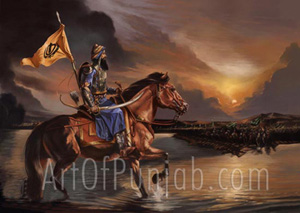 and the works of lesser known artists displayed on Sikh calendars (the hallmarks of almost every Sikh-owned business) of course. Until recently, Sikh-themed art seemed to be limited to the afore mentioned. No longer! A number of artists have come out with Sikh-themed art and there are two that I would like to highlight in particular.
and the works of lesser known artists displayed on Sikh calendars (the hallmarks of almost every Sikh-owned business) of course. Until recently, Sikh-themed art seemed to be limited to the afore mentioned. No longer! A number of artists have come out with Sikh-themed art and there are two that I would like to highlight in particular.
First is Kanwar Singh Dhillon, a Punjab-born Canadian whose works are themed around Sikh history. I was attracted by the detail in his art and was surprised to learn that he uses a rather unique medium – although his 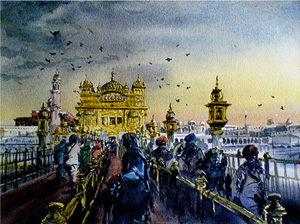 works look as if they are done in oil on canvas – his paintings are computer created and printed onto the canvas. Needless to say the product is still wonderful.
works look as if they are done in oil on canvas – his paintings are computer created and printed onto the canvas. Needless to say the product is still wonderful.
The other artist is Bhupinder Singh. I came across his art long before I knew who he was. I actually had the painting titled “Gurdwara Entrance” (pictured) as my desktop background for the longest time, and admired it every time I sat at my computer. It was only after I came across a second painting by him on flicker.com (which reminded me of the first) that I started poking about the net. His medium of choice is watercolor –making his work both unique and striking.
Please feel free to post your thoughts and about any cool works of art or artist that you know of. Note – I know there are other artists out there, but I chose to post about these two because they are new to me.



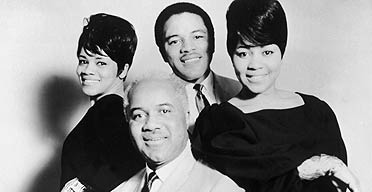 The music of the Staple Singers soundtracked the civil rights movement: it was their songs that were sung on protest marches; Martin Luther King was a close friend of Pops Staples. “Pop, he always told the songwriters: if you wanna write for the Staples, read the headlines,” she says. “‘Cause we wanna sing about what’s happening in the world.
The music of the Staple Singers soundtracked the civil rights movement: it was their songs that were sung on protest marches; Martin Luther King was a close friend of Pops Staples. “Pop, he always told the songwriters: if you wanna write for the Staples, read the headlines,” she says. “‘Cause we wanna sing about what’s happening in the world.